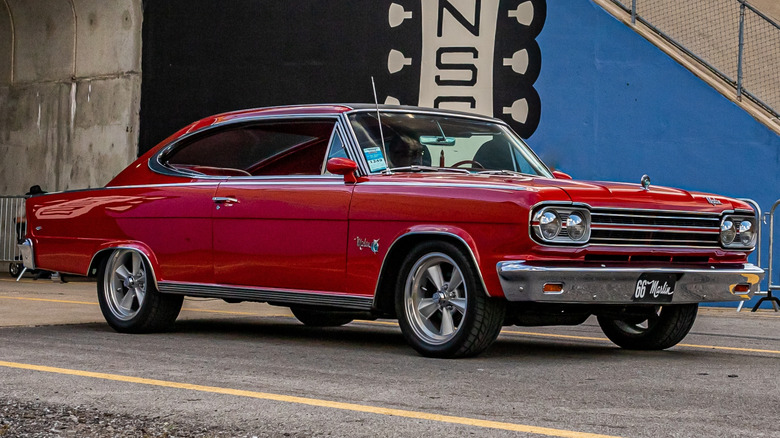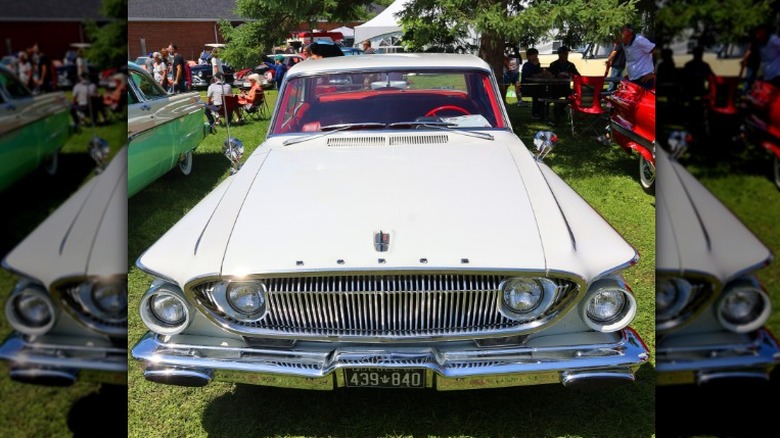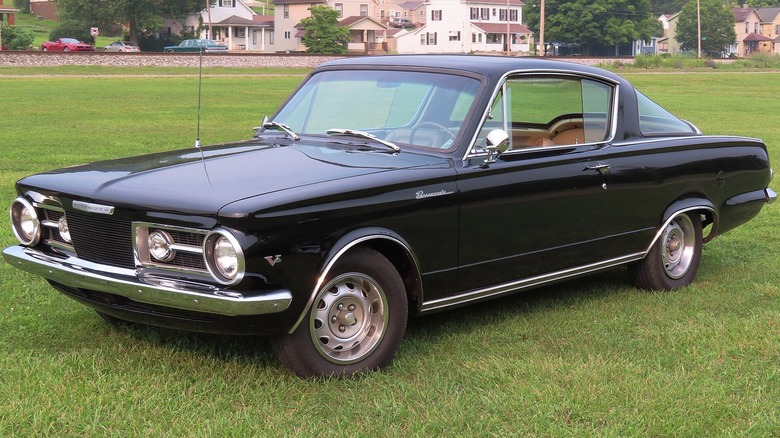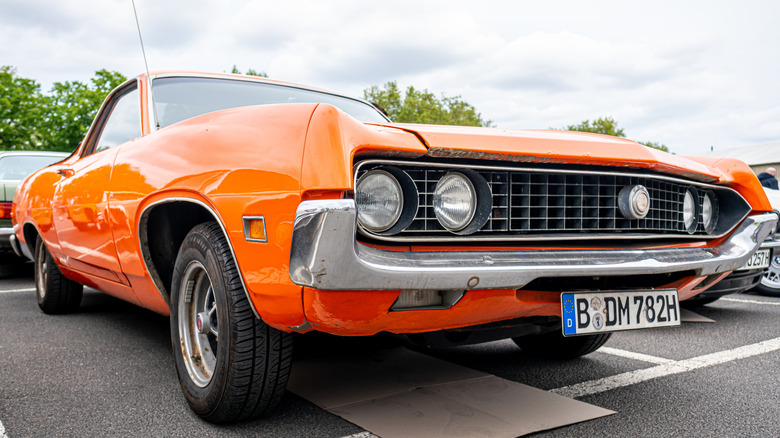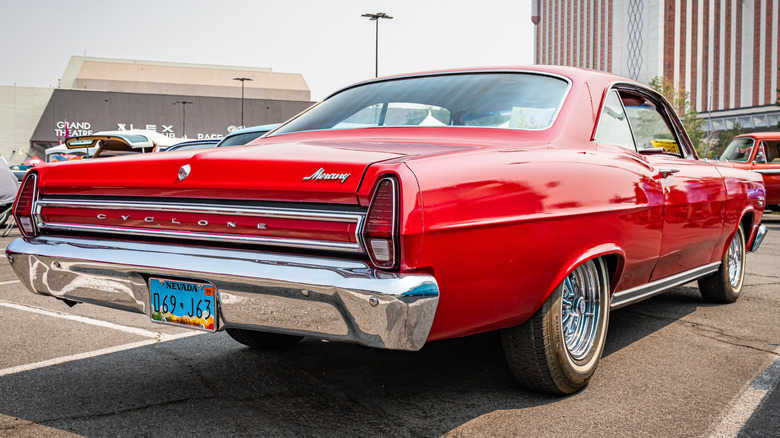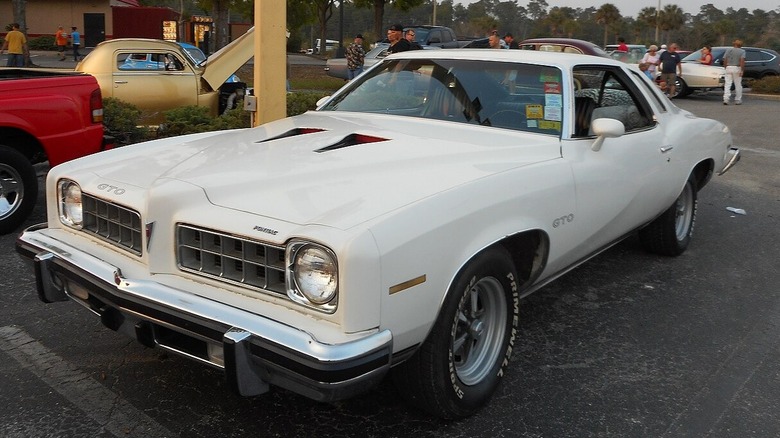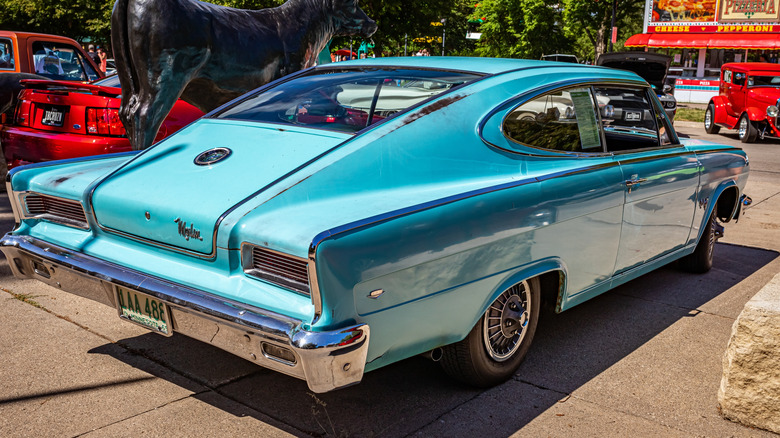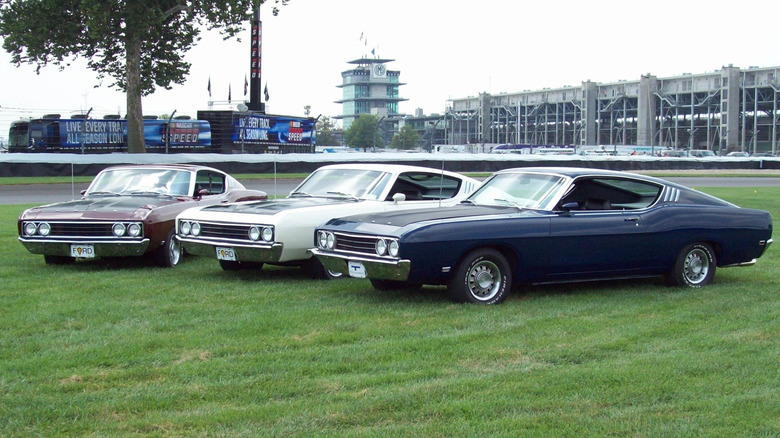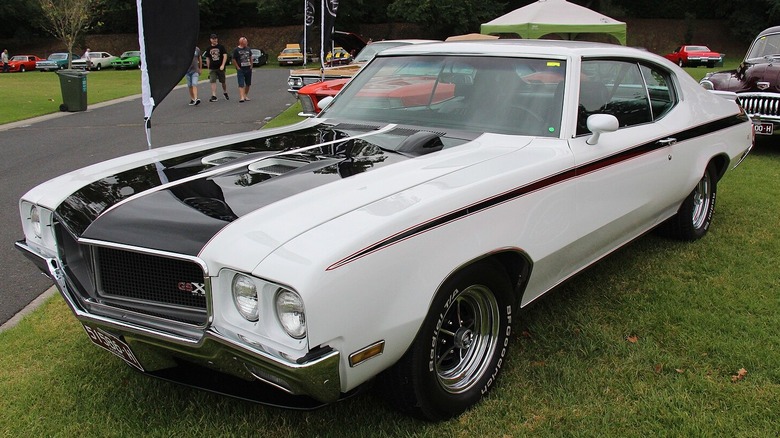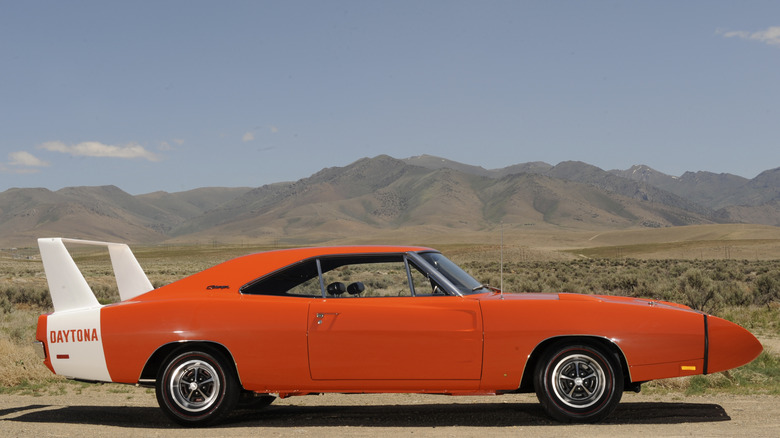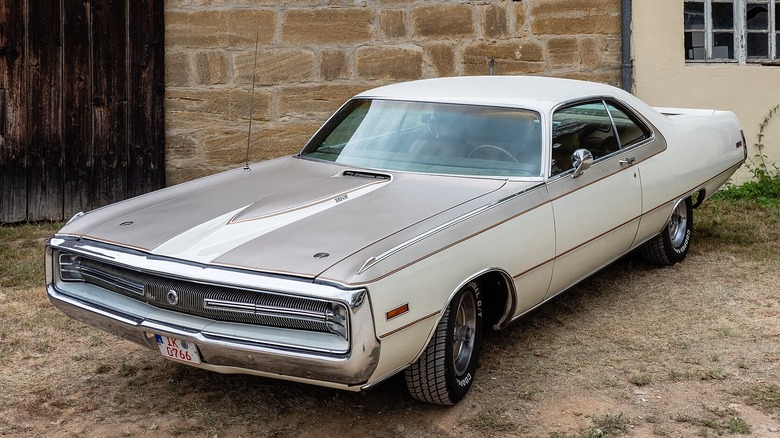10 Of The Worst-Selling Muscle Cars Of All Time
Take a relatively lightweight two-door midsize or compact car and stuff a big V8 under the hood — this formula was born in Detroit in the mid-1960s, and it defined the classic muscle car era for about a decade. While a handful of muscle cars were never sold in America, this category is a uniquely American contribution to automotive culture, creating some hot-selling models like the 1966 Pontiac GTO, which moved almost 97,000 units. Yet the worst-selling muscle cars of all time fell far short of this.
When determining muscle car sales figures, the first challenge involves deciding which cars belong in this category. The definition above is very general, and if you ask an enthusiast for the specific years of the muscle car era the answer will probably be 1964 — when the first GTO was introduced — through 1973 when new emissions controls and the OPEC oil shocks brought the era to an end. Still, the formula fits some cars made before 1964. Some experts even believe the Oldsmobile 88 was one of the first muscle cars way back in 1949.
Therefore it's fair to include models from earlier than 1964, although 1973 remains a hard cut-off. Next, when considering which models were poor-selling, we need to consider expectations for each model. For instance, several models were built specifically for drag racing teams and sold only a few dozen units. Those wouldn't be considered sales failures. However, other models targeted at mainstream drivers fell far short of expected sales, even if those sales were in the tens of thousands. These cars will make this list.
With all that in mind, here are ten poor-selling muscle cars arranged roughly in reverse order of their sales figures.
1962 Dodge Dart
The 1962 Dodge Dart was born from a mistake and ended up being such a sales failure that it was redesigned after only one model year. Chrysler executives mistakenly believed Chevy planned to downsize its full-sized models, so they ordered a rushed redesign of the 1962 Dart. The result was one of the odder mainstream models of the 1960s, one that was not quite full-sized but just a bit too big to be considered midsize, with swoopy Jet Age styling that had to be shrunk down at the last minute to fit the smaller platform.
While the '62 Dart came in a range of body styles including coupes, sedans, and station wagons, it belongs on this list because its Max Wedge V8 is considered one of the first muscle car engines by many enthusiasts. Time travel back to 1962, order a two-door Dart, tick the option box for the Max Wedge V8, and you have a classic muscle car. While the Max Wedge was intended for drag racing and could be a handful on the street, the Dart also offered three other V8 options, topping out with the 361 cubic inch, four-barrel 305 horsepower V8 in the Dodge Polara, which was essentially an upscale version of the Dart.
Sadly, the Dart's new styling proved so controversial that sales of the overall Dart lineup plummeted from 307,000 in 1960 to just 110,000 by the end of 1962. Of that number, it's hard to break out how many were V8-powered coupes that would be considered muscle cars, but it's safe to assume that poor sales for the whole lineup also means poor sales for the performance-oriented Darts. This makes the '62 Dart an early example of a muscle car whose sales fell far short of expectations.
1964-1965 Plymouth Barracuda
Given that the Barracuda would go on to become one of the most well-known names in Mopar history in its later model years, it may surprise some people to learn that the 'Cuda was a bit of a sales flop upon its introduction. Created to rival the rumored new model from Ford called the Mustang, it used a Plymouth Valiant as its base but added distinctive styling variations such as a huge, curving rear window sloping down to a small trunk between two vestigial tail fins. At first glance, its fastback profile almost looks like a hatchback.
The 1964 Barracuda's base engine was an inline-six, but enthusiasts could opt for a 273 cubic inch 2-barrel V8. With mechanical lifters and wedge-shaped combustion chambers, this motor produced 180 horsepower and 260 lb-ft of torque at a low 1,600 RPM. This was decent power for its day, especially with the nice low-end grunt from its torque. Yet other V8s of the era outshone it, including the 289 cubic inch, 271 horsepower V8 offered late in 1964 by the Mustang.
Sales weren't terrible, with Plymouth moving 23,443 Barracudas in a short model year in 1964, including both V6 and V8 variants. It would go on to sell 65,000 units in its first full model year in 1965 with a more powerful 235 horsepower V8. Nevertheless, in light of the runaway success of the Mustang, which sold 419,000 units in its first 365 days on the market, the Barracuda's debut year was not a sales success. However, Plymouth stuck with it, eventually growing the 'Cuda into one of the most beloved names in muscle car lore.
1970 Ford Torino Cobra
The Ford Torino was a midsize mainstream model, but those with the Cobra badge brought something special to the muscle car game with Ford's 429 Cobra Jet V8. A version of this engine achieved the status of legend as the Boss 429 in the Boss Mustang, a racing homologation special. The Cobra Jet was the street version of the Boss 429.
With an 11.3:1 compression ratio, enlarged intake and exhaust valve diameters, and a four-barrel Rochester Quadrajet carburetor, the 429 Cobra Jet cranked out 370 horsepower, an increase of 10 over the Thunder Jet in the base Torino Cobra — and yes, Ford's designations could get confusing in those days, as the base Torino Cobra didn't have the Cobra Jet engine. A Ram Air intake option allegedly added no extra horsepower, but it's possible Ford was trying not to draw too much attention to the monster in its showroom by understating its power.
There was also a Super Cobra Jet option, available by choosing the Drag Pack. The Super Cobra Jet delivered durability for racing, with stronger connecting rods, a solid lifter cam, forged aluminum pistons, a Holley carburetor, and other beefed-up components. The Super Cobra Jet, like the Ram Air Cobra Jet, was almost certainly underrated at 375 horsepower. Perhaps Ford sensed the tide turning against ultra-high horsepower engines and wanted to keep this one on the down low.
Alas, having one of the best engines ever put in a Ford muscle car didn't translate into sales. Only 7,675 Torino Cobras and fewer than 1,500 Torino Super Cobra Jet models left Ford showrooms that year. This paled beside Mustang sales, leaving the Torino Super Cobra to be savored by those who appreciate rare, high horsepower muscle cars.
1964-1971 Mercury Cyclone
The Mercury Cyclone is such an overlooked entrant in the annals of muscle car lore that even some enthusiasts of that era don't know much, if anything, about it. It resulted from Ford's Total Performance racing initiative, the Blue Oval's response to an increasing focus on horsepower by its rivals, particularly Pontiac. Throughout the Cyclone's run from 1964 through 1971 it struggled to find its place in a market dominated by more famous cars including its cousin, the Mustang. Despite all these challenges, however, some still consider it one of the most underrated muscle cars ever made.
Just as the compact Ford Falcon played a role in the birth of the Mustang, it also provided the basis for the first Cyclone, then known as the Comet Cyclone. Its big V8 in a compact car formula was nearly identical to that of the Mustang, but arguably with a more elegant and grown-up style. Yet even with the available Hi-Po 289 V8 and its 271 horsepower, sales were disappointing. Only 7,454 1964 Comet Cyclones left Mercury dealers' lots.
The Cyclone's focus on power culminated in engines like the 427 V8 in 1967, of which only 27 were made, and the 428 Cobra Jet in 1969. In that same year, Mercury released a NASCAR homologation model called the Spoiler II. By 1970, the Cyclone offered a 429 Cobra Jet option producing 370 horsepower. Yet despite this firepower under the hood and a move to a midsize platform in 1966, the Cyclone continued to languish in the shadow of cars like the Mustang and the Pontiac GTO. In its best year, sales totaled fewer than 21,000, and by its final model year in 1971 sales had dwindled to just over 3,000.
1973 Pontiac GTO
By 1973 the muscle car culture began to decline as OPEC embargoes along with anti-smog equipment, unleaded gas requirements, and other federally mandated controls sapped horsepower. Insurance rates were rising, too. As a result, the Pontiac GTO, which carried one of the most glorious and storied names of the horsepower wars, sold only 4,806 units, a far cry from the almost 97,000 GTOs sold in 1966.
The '73 GTO actually produced a respectable amount of horsepower from its top-of-the-line engine choice, the Super Duty 455 V8. This power plant generated 310 horses and a very decent 370 lb-ft of torque. This ranked as the highest output of any engine sold in an American car that year. Yet it fell far short of the highest horsepower Pontiac engines ever built in the muscle car era, like the 390 horsepower 428 H.O. which could be tuned out to 425 ponies.
The 1973 GTO's styling proved controversial, too. Newly required 5 MPH bumpers jutted out from the front beneath a prominent nose dividing the grille. The pillarless hardtop profile was replaced with a B-pillar that produced a rear quarter window that could optionally be equipped with louvers. The rear deck sloped dramatically downward toward small, horizontal tail lights. Opinions were divided at the time, although in the decades since the '73 GTO's looks have come to be appreciated by collectors. Time has been kind to this car in people's memories, but it didn't draw traffic into showrooms in its day.
1965-1966 AMC Rambler Marlin
AMC always built quirky cars that stood out from the more mainstream models produced by Detroit's Big Three, but the 1965 and 1966 AMC Rambler Marlin proved too much even for AMC fans, with sales totaling only 10,327 in 1966 and a paltry 4,547 in 1966. A redesign in 1967 caused sales to fall even further to just 2,545 units, leading to the model's cancellation after that year.
Its odd design obscured the fact that it was available with a pretty decent V8 that made the Rambler Marlin an early example of a muscle car. The Rambler Marlin was born from a sleek fastback concept car called the Rambler Tarpon. The concept car featured a 2+2 coupe design, but AMC executives wanted a larger, family-sized car, albeit still a two-door.
The goal was to increase rear-seat headroom, but the result was an odd hybrid of a sleek, muscle car front end and a bulbous rear end, almost like two cars grafted together like Frankenstein's monster. From some angles it still looks sporty and aggressive, but from other angles it produces an effect of "what were they thinking?"
This is a pity because the Rambler Marlin offered a fairly potent 327 cubic inch V8. This engine produced 250 horsepower with a two-barrel carburetor, while a four-barrel version boosted that number to 270. This made the Rambler Marlin one of the trailblazers of the muscle car era, beloved by collectors today but not dominating in the showroom when it was new.
1969 Ford Torino Talladega
It might seem a little unfair to call the Torino Talladega a poor-selling model when Ford only intended to produce a small number of them in order to qualify the model for NASCAR racing, a tactic called homologation. Still, when the dispute concerns whether 750 or 754 of them were built, it definitely qualifies as a low seller.
While NASCAR teams got the version of the Torino Talladega with the feisty Boss 429 V8, street versions got the easier-to-tame but still very wild 428 Cobra Jet. With a 10.6:1 compression ratio, a cast iron block, a Holley four-barrel carb, and other street-brawler specs, the 428 Cobra Jet unleashed 335 horsepower and an earth-shaking 440 lb-ft of torque.
Special bodywork allowed the Torino Talladega to ride lower to the ground for more downforce. Its Competition Suspension sported independent and unequal-length control arms, an anti-sway bar, and other high-tech components. Interiors were Spartan, stripped of most unnecessary features to save weight. Its racing genes showed in nearly every part of the car.
The result was a 0-60 time of about five and a half seconds and a sub-15 second quarter mile, impressive numbers for a relatively large car. Racing models could hit 190 MPH, but street versions reached a more manageable 130 MPH. Buyers had to want a bare-bones race car, and more than enough of them did to meet the homologation requirement of 500 sales – but not much more. Today it's a highly valued classic.
1970-1971 Buick GSX
Buick tends to get overlooked in the annals of muscle car lore, being better known for luxurious and stylish vehicles like the Riviera. But Buick took a real shot at the muscle car market with the GSX, one of the fastest Buicks ever made. This is not your Uncle Lenny's Park Avenue.
The GSX looked the part, with muscular flanks, functional hood scoops, rally wheels, and Saturn Yellow or Apollo White paint jobs set off by wide, black racing stripes. But under the hood was where the GSX really delivered, housing a 455 cubic inch, 350 horsepower V8. Its torque rated an amazing 510 lb-ft. The optional Stage I upgrade boosted horsepower to 360. The general consensus among gearheads is that power for both versions of this motor was understated for insurance reasons and that the Stage I might have made more than 400 horsepower.
That makes the GSX much more than an also-ran in the muscle car competition. Quarter mile times were under 14 seconds. But Buick only sold 678 of them in the model's first year. 1971 sales figures weren't much better, leaving the GSX to be an ultra-rare and highly desirable collectible.
1969 Dodge Charger Daytona
The 1969 Dodge Charger is known to millions as the iconic Dukes of Hazzard car nicknamed the General Lee. The Charger itself was a common enough vehicle that the show may have destroyed hundreds of Dodge Chargers while filming its stunts. However, there's a variant of the Charger that's much too rare and far, far too valuable to destroy for TV stunts — the Dodge Charger Daytona.
The Charger Daytona was another homologation special like Ford's Torino Talladega, so sales were bound to be low, and indeed only 505 Charger Daytonas were sold (officially). However, Dodge dealers could have sold far more if Dodge hadn't pressured them not to, as legend has it that dealerships had 1,200 orders waiting. This may have been in part because Dodge lost money on each Charger Daytona, and only wanted to sell enough to qualify for NASCAR racing series.
The Daytona sported a 426 Hemi V8 officially rated at 425 horsepower. Still, power was only part of the car's performance arsenal — the rest was aerodynamics. To compensate for rear-end lift in the previous year's NASCAR model, the '69 sported a towering rear wing spoiler that generated huge downforce, sticking the cars to the track. A pointed nose with pop-up headlights made the Daytona's profile even slicker.
After some initial issues with tire wear, the Charger Daytona became a monster at the track, winning 80 percent of its races during that season. Today it's a priceless collectible, with one selling for $3.3 million in 2024. You won't see that car jumping a creek in Hazzard County anytime soon.
1970 Chrysler 300 Hurst Edition
By the early 1970s, the trend in American cars was to get bigger and bigger, although the oil shocks of the '70s would eventually put a damper on that. Before that, however, Chrysler expanded the muscle car formula to its full-sized 300 model, although only 485 buyers brought one home.
The 1970 Chrysler 300 Hurst Edition forms an exception to the muscle car rule of putting big engines in small(ish) cars. The 300 was a full-sized, 4,200-pound car that normally served as a personal luxury coupe. To give it enough grunt to be called a muscle car, Chrysler dropped an enormous engine into it — the company's 440 big block Wedge. With 375 horsepower and 480 lb-ft of torque, this motor was up to the task of moving the 300 Hurst Edition in a hurry.
The Hurst conversion process took place at Hurst's facility in Warminster, Pennsylvania. It included gold-painted accents, a lightweight fiberglass hood and trunk lid, a rear spoiler, and special emblems. Since the custom trunk lid eliminated the lock, a vacuum-powered trunk release was built into the glove box. The rest of the interior didn't need much upgrading, since it featured plush leather seating originally intended for the top-of-the-line Chrysler Imperial.
Despite its rarity, the 300 Hurst Edition doesn't fit comfortably into the world of muscle-car collecting. It's just too big, and too much of a plush Chrysler. Thus it's only worth in the ballpark of $50,000 today, making it a bargain for someone who wants to nab a real example of the golden age of muscle cars.
